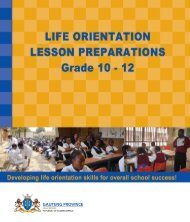Life Science Grade 11
Life Science Grade 11
Life Science Grade 11
You also want an ePaper? Increase the reach of your titles
YUMPU automatically turns print PDFs into web optimized ePapers that Google loves.
<strong>Grade</strong> <strong>11</strong> <strong>Life</strong> <strong>Science</strong>s Lesson PlansGRADE <strong>11</strong> SUBJECT <strong>Life</strong> <strong>Science</strong>s WEEK 8 TOPIC Animal diversity Lesson 4LESSON SUMMARY FOR: DATE STARTED:LESSON OBJECTIVESDATE COMPLETED:Content: (CAPS p 41)• The relationship between body plans and modes of living for each of the six phyla; similarities and differences.• The role of invertebrates in agriculture and ecosystems (e.g. pollination, decomposition, soil aeration etc.)The learner must be able to:TEACHER ACTIVITIES LEARNER ACTIVITIES TIMING RESOURCES NEEDED1.1 IntroductionUse going through the homework from the previous two lessons as a way todetermine how much the learners know2.2 Main Body (Lesson presentation)Using the tables which learners completed in the previous lesson learners are todiscuss the relationship between body plans and modes of living for each of the sixphyla.Solutions for all have an activity (classroom activity 8 p 107) and a phylogentic treewhich shows how the various body plans of the 6 phyla are related.Alternatively in the 2012 Gr <strong>11</strong> SBA there is a diversity essay which learners couldcomplete (Animal Diversity research assignment p130)Discuss with learners the role of invertebrates in agriculture and ecosystems.• What are invertebrates? Which phyla are considered invertebrates?Animals without a backbone, including: Porifera, Cnaidaria, Platyhelminthes,Annelida and Arthropoda.• Play an important role in food chains and food webs.• Many soil invertebrates are responsible for maintaining soil fertilitiy throughdecomposition processes e.g. dung beetles and maggots.• Many improve the soil quality by improving the water holding capacity of thesoil and the amount of the air within the soil e.g. annelids.• Many insects, e.g. bees and butterflies play an important role in pollination.• Coral reefs form provides a safe habitat where many fish hide away frompredators.• Some Cnidarians live in symbiotic relationships with other animals, e.g the seaanemone provides protection for the clown fish• Many invertebrates are parasites e.g. ticks and tape worm.• Some arthropods are vectors of certain diseases e.g., the anopheles mosquitocarries Plasmodium which causes malaria.• Some Arthropods are pests, destroying crops. In an attempt to limit the amountof damage caused by Arthropods farmers spray their crops with insecticides orpesticides.Learners provide answers to the homeworkquestions.Using their tables learners complete anactivity where they discuss the relationshipbetween body plans and modes of living foreach of the six phyla.DL TO CHECKSolutions for all Activity 8 p107Gr <strong>11</strong> SBA 2012 p130Chalkboard, OHT, powerpointTerm 1 Page 78© Gauteng Department of Education (CAPS version)







